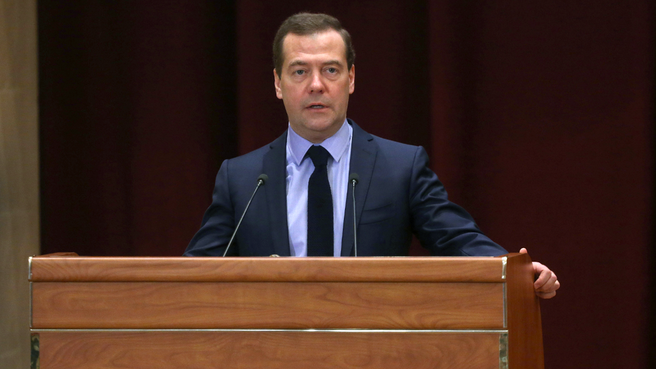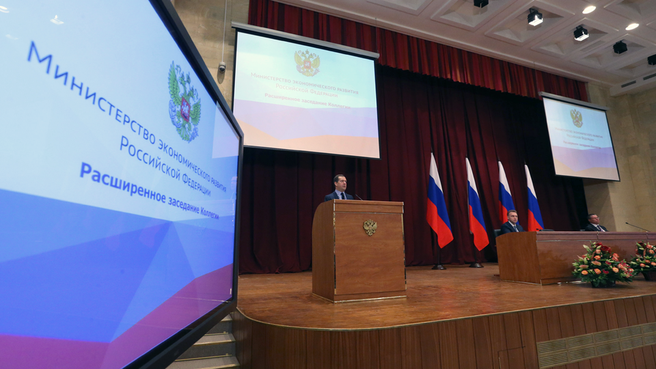Ministry’s performance in 2014 and objectives for the upcoming period.
Excerpts from Dmitry Medvedev’s opening remarks:
One of last year’s key objectives was to promote the full-fledged integration of two new constituent entities, the Republic of Crimea and the city of Sevastopol, into Russia’s economic system. This was an unprecedented task, one which we had never faced before in Russia’s recent history. We had to act swiftly to create a regulatory framework, address numerous organisational and financial issues and train government officials. Overall, we have completed these tasks. By and large, the Republic of Crimea and Sevastopol have become integrated into the fabric of Russia’s governance system and economy.
The Russian economy has come under gruelling pressure. On top of that, intrinsically domestic economic challenges, our structural problems, are still there. Last year, economic growth lost much of its momentum, and this year it fell, slipping into the red.
Nevertheless, a certain stabilisation did take place. We hope that the inflation peak is behind us. That said, the negative trends in general continue to linger. Forecasts on the main macroeconomic indicators are quite grim. We believe that the initiatives the Government is undertaking to support industrial output, agriculture and the banking sector, and to promote import substitution, will accelerate recovery.
We are aware of the challenges the Russian economy is facing all too well. Above all they consist of its dependence on oil and gas and a lack of efficiency; declining investment while large-scale infrastructure development projects have yet to be implemented; the much smaller share of small and medium-sized businesses in the economy compared to the majority of other countries; unreasonably high costs; and poor governance across the board, especially in the public sector.
The decline in investment is especially alarming. A number of mechanisms have been put in place to sustain investments, and new ones are expected to be rolled out in the near future. However, what really matters is creating conditions that would facilitate the inflow of private, not only government, investment into the real economy.
The issue that haunts almost all sectors of the Russian economy is unreasonably high, if not critically high, costs, which result, among other things, from wages growing faster than labour efficiency.
Another major factor pushing costs up are tariffs of natural monopolies.
Cutting red tape and removing administrative barriers is an important task. The roadmaps devised by our initiative for entrepreneurship are to be implemented by the end of the year.
Promoting the development of small and medium-sized enterprises should become a special priority for us. In order to make life easier for small companies, a moratorium on tax increases and social security contributions to state extra-budgetary funds has been introduced till 2018. Moreover, SMEs will benefit from tax breaks under the plan of priority measures for sustainable development.
We also must take action to improve the availability of loans, including through government guarantees. The state assumes a share of the costs that are not related to the core business operations of small businesses, such as administrative costs and spending on infrastructure. It is for this reason that we must continue to develop industrial parks, innovation clusters and competence centres.
An import substitution programme has been devised to support Russian producers with such measures as providing preferences to state and municipal companies in government procurement. That said, we should be cautious not to hinder competition.
We are creating a one-stop-shop system, and it goes without saying that these efforts should be seen through to their conclusion. A single export promotion centre is already operating within the Export Insurance Agency and Eximbank of Russia.
We need to step up our efforts in promoting research and development, implementing innovations and bringing them to the market. A system for delivering on this objective is already taking shape. The Innovative Development Strategy until 2020 has been approved and is already being implemented. A pool of development institutions has been created, and 60 partially government-owned companies are already carrying out their own innovative development programmes, thereby stimulating demand for Russian high-tech solutions.
By 2018, Russia’s economic growth rate should be not lower than the global average.
While the external
conditions remain unfavourable, and we do not expect them to improve anytime
soon, we need to learn to work and live in this new environment despite any
apocalyptic forecasts. In fact, we have already learned to do this. It is
obvious that our economy has sufficient reserves not only to survive, but also
to develop in an extremely complex environment.









